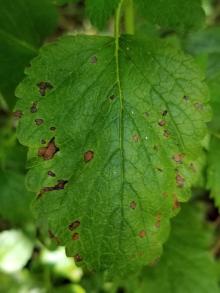Cause Leaf spots are common on lemon balm grown in PNW gardens but little work has been done on these problems. None have been formally reported in the PNW but the OSU Plant Clinic has found Phyllosticta and TSWV on the few samples that have been sent in. The fungi Phyllosticta decidua (now named Boeremia exigua var. exigua), Alternaria alternata, Botrytis cinerea, and Septoria melissae have all been found causing leaf spots in other regions of the world where lemon balm is grown. Most fungal leaf spots are favored by wet weather and/or overcrowding that keeps leaves wet for extended periods of time. They generally survive unfavorable conditions in plant debris.
Symptoms Phyllosticta - Small spots with brown rounded edges. Spots start very small and randomly scattered on the leaf. Black fruiting bodies (pycnidia) develop in the center of spots. Stems may be infected where chlorotic spots form, dry and become gray-brown. Stem tissue may also crack. Plants may die if heavily infected but is not a common symptom.
Septoria - Small distinct and discolored lesions occur which enlarge turning dark brown, angular and necrotic with a purplish-brown margin. Black fruiting bodies (pycnidia) develop in the center of spots.
TSWV - The one sample in the OSU Plant Clinic had chlorotic areas in sectors and deformed leaves.
Cultural control
- Remove and destroy infected leaves and/or plants as they appear.
- Remove fallen leaves and plant debris.
- Plant in an area with good air circulation and morning sun.
- Avoid overhead irrigation, or water such that plants are not wet for extended periods of time.
Chemical control No fungicides have this crop on the label.
Reference Nakova, M. and Vasileva, K. 2017. Phyllosticta decidua Ellis et Kellerman - A new pathogen on lemon balm (Melissa officinalis L.) in Bulgaria. Agricultural Sciences-Journal of the Agricultural University-Plovdiv. 9:53-58.
Yang, S.A., Choi, I.Y., Ju, H.J., Lee, K.J., Galea, V. and Shin, H.D. 2020. Occurrence and Characterization of Leaf Spot Caused by Septoria melissae on Lemon Balm in Korea. Mycobiology. 48:495-500.



